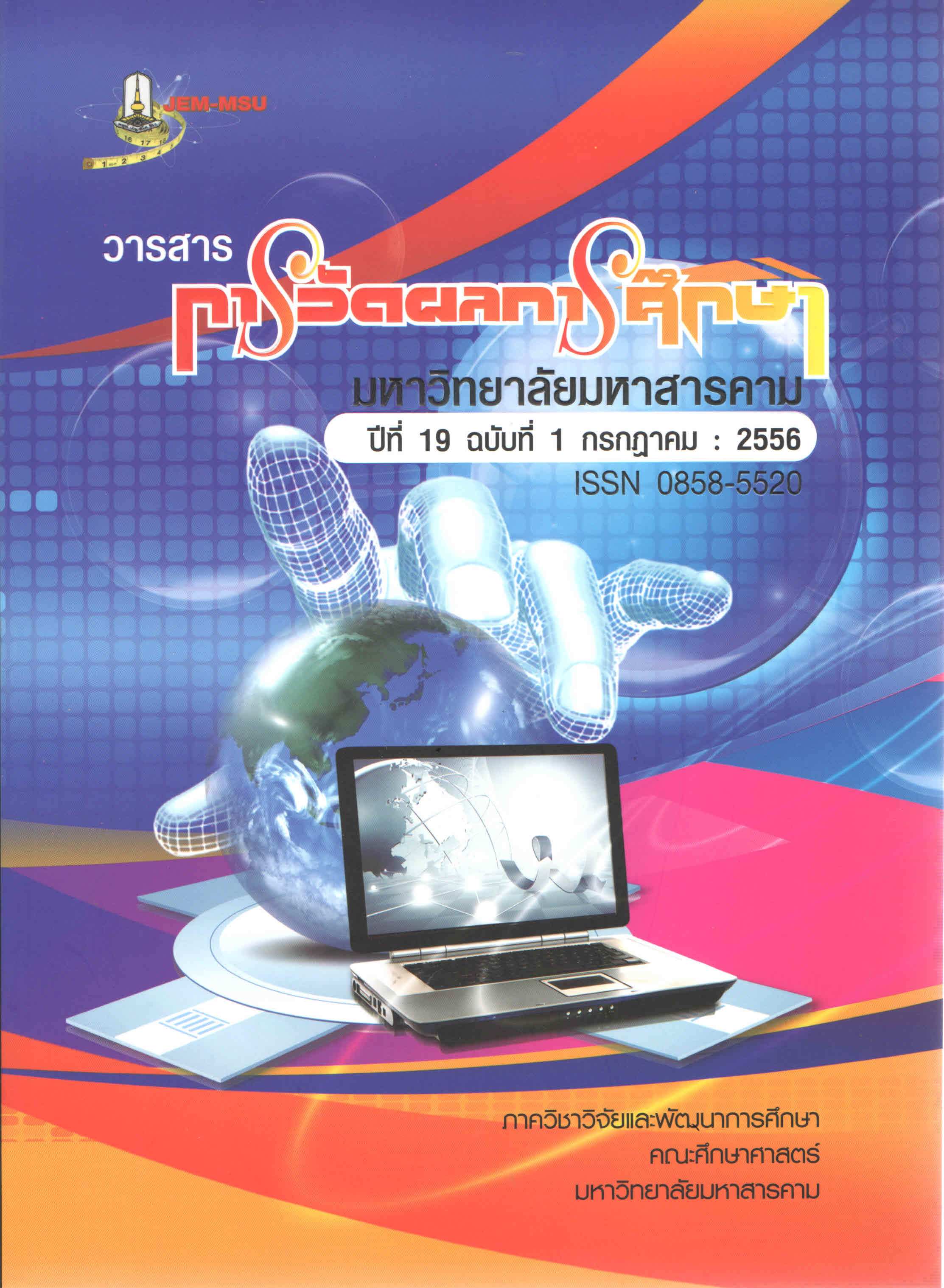การวิเคราะหพหุระดับ ปจจัยที่มีอิทธิพลตอความสามารถดานการใชเทคโนโลยีสารสนเทศ ของนักเรียนระดับชั้นมัธยมศึกษาปที่ 2 สังกัดสํานักงานเขตพื้นที่การศึกษามัธยมศึกษา เขต 25
Main Article Content
บทคัดย่อ
การวิจัยครั้งนี้มีจุดมุ่งหมายเพื่อศึกษาตัวแปรระดับนักเรียนและตัวแปรระดับห้องเรียนที่มีอิทธิพลต่อ
ความสามารถด้านการใช้เทคโนโลยีสารสนเทศ เพื่อสร้างสมการพยากรณ์ตัวแปรที่มีอิทธิพลต่อความสามารถ
ด้านการใช้เทคโนโลยีสารสนเทศของนักเรียนระดับชั้นมัธยมศึกษาปีที่ 2 สังกัดสํานักงานเขตพื้นที่การศึกษา
มัธยมศึกษา เขต 25 โดยการวิเคราะห์พหุระดับ กลุ่มตัวอย่างเป็นนักเรียนชั้นมัธยมศึกษาปีที่ 2 จํานวน 1,079 คน
จาก 24 โรงเรียน ซึ่งได้มาโดยการสุ่มแบบหลายขั้นตอน (Multi-stage Random Sampling) เครื่องมือที่ใช้ในการ
วิจัยครั้งนี้ ประกอบด้วย แบบทดสอบความรู้พื้นฐานเดิมเกี่ยวกับความสามารถด้านการใช้เทคโนโลยีสารสนเทศ
จํานวน 15 ข้อ แบบวัดและแบบสอบถามเกี่ยวกับปัจจัยที่มีอิทธิพลต่อความสามารถด้านการใช้เทคโนโลยีสารสนเทศ
ประกอบด้วย 1) เจตคติต่อการใช้เทคโนโลยีสารสนเทศ 2) ทักษะการแสวงหาความรู้ 3) แรงจูงใจใฝ่สัมฤทธิ์
4) อิทธิพลของสื่อมวลชน 5) การสนับสนุนของผู้ปกครอง 6) การอบรมเลี้ยงดู 7) อิทธิพลของเพื่อน 8) คุณภาพการ
สอนของครู 9) แหล่งการเรียนรู้ภายในโรงเรียน 10) ความสามารถในการใช้เทคโนโลยีสารสนเทศ จํานวน 60 ข้อ
วิเคราะหืข้อมูลด้วยสถิติพื้นฐาน การวิเคราะห์สัมประสิทธิสหสัมพันธ์ภายใน ด้วยโปรแกรมคอมพิวเตอร์ การวิเคราะห์
ข้อมูลใช้การวิเคราะห์พหุระดับ (Multilevel Analysis) ด้วยเทคนิคโมเดลเชิงเส้นตรงระดับลดหลั่นโดยใช้โปรแกรม
คอมพิวเตอร์
ผลการวิจัยพบว่า
1. ตัวแปรอิสระระดับนักเรียนที่มีอิทธิพลต่อความสามารถด้านการใช้เทคโนโลยีสารสนเทศของ
นักเรียนระดับชั้นมัธยมศึกษาปีที่ 2 สังกัดสํานักงานเขตพื้นที่การศึกษามัธยมศึกษา เขต 25 อย่างมีนัยสําคัญทางสถิติ
ที่ระดับ .01 และ .05 ได้แก่ ความรู้พื้นฐานเดิมเกี่ยวกับการใช้เทคโนโลยีสารสนเทศ และเจตคติต่อการใช้เทคโนโลยี
สารสนเทศ ตามลําดับ โดยที่ตัวแปรอิสระระดับนักเรียนสามารถร่วมกันอธิบายความผันแปรของความสามารถด้าน
การใช้เทคโนโลยีสารสนเทศของนักเรียนระดับชั้นมัธยมศึกษาปีที่ 2 สังกัดสํานักงานเขตพื้นที่การศึกษามัธยมศึกษา
เขต 25 ได้ร้อยละ 62.80 2. ตัวแปรระดับห้องเรียนที่มีอิทธิพลต่อความสามารถด้านการใช้เทคโนโลยีสารสนเทศของนักเรียน
ระดับชั้นมัธยมศึกษาปีที่ 2 สังกัดสํานักงานเขตพื้นที่การศึกษามัธยมศึกษา เขต 25 อย่างมีนัยสําคัญทางสถิติที่ระดับ
.05 คือ อิทธิพลของเพื่อน โดยที่ตัวแปรอิสระระดับห้องเรียนสามารถร่วมกันอธิบายความผันแปรของความสามารถ
ดีานการใช้เทคโนโลยีสารสนเทศของนักเรียนระดับชั้นมัธยมศึกษาปีที่ 2 สังกัดสํานักงานเขตพื้นที่การศึกษา
มัธยมศึกษา เขต 25 ได้ร้อยละ 25.50
3. สมการพยากรณ์ทํานายตัวแปรระดับนักเรียนและตัวแปรระดับห้องเรียนที่มีอิทธิพลต่อความสามารถ
ด้านการใช้เทคโนโลยีสารสนเทศของนักเรียนระดับชั้นมัธยมศึกษาปีที่ 2 สังกัดสํานักงานเขตพื้นที่การศึกษา
มัธยมศึกษา เขต 25 โดยการวิเคราะห์พหุระดับ ได้สมการดังนี้
การวิเคราะห์ระดับนักเรียน (Micro-Level Analysis)
CAPS
ij = 3.986 + 0.022**(BASIC1)ij + 0.128*(ATT)ij
การวิเคราะห์ระดับหองเรียน (Macro-Level Analysis)
β0j = 3.985 + 0.191*(PEER)
BASIC1(β1j) = 0.033 + 0.039*(PEER)ij
โดยสรุป ปัจจัยที่มีอิทธิพลต่อความสามารถด้านการใชีเทคโนโลยีสารสนเทศของนักเรียนระดับชั้น
มัธยมศึกษาปีที่ 2 สังกัดสํานักงานเขตพื้นที่การศึกษามัธยมศึกษา เขต 25ในระดับนักเรียน คือ ความรู้พื้นฐานเดิม
เกี่ยวกับการใช้เทคโนโลยีสารสนเทศ เจตคติต่อการใช้เทคโนโลยีสารสนเทศ และในระดับห้องเรียน คือ อิทธิพล
ของเพื่อน ซึ่งในแต่ละปัจจัยนั้นต่างมีความสัมพันธ์เชื่อมโยงกันทั้งสิ้น ดังนั้น ผู้บริหาร คณะครู พ่อแม่หรือผู้ปกครอง
และผู้ที่มีส่วนเกี่ยวข้องควรเสริมสร้างปัจจัยเหล่านี้แก่นักเรียน เพื่อให้นักเรียนมีความสามารถด้านการใช้เทคโนโลยี
สารสนเทศมากยิ่งขึ้น
Article Details
เนื้อหาและข้อมูลในบทความที่ลงตีพิมพ์ในวารสารการวัดผลการศึกษา มหาวิทยาลัยมหาสารคาม ถือเป็นข้อคิดเห็นและความรับผิดชอบของผู้เขียนบทความโดยตรง ซึ่งกองบรรณาธิการวารสาร ไม่จำเป็นต้องเห็นด้วย หรือร่วมรับผิดชอบใดๆ
บทความ ข้อมูล เนื้อหา รูปภาพ ฯลฯ ที่ได้รับการตีพิมพ์ในวารสารการวัดผลการศึกษา มหาวิทยาลัยมหาสารคาม ถือเป็นลิขสิทธิ์ของวารสารการวัดผลการศึกษา มหาวิทยาลัยมหาสารคาม หากบุคคลหรือหน่วยงานใดต้องการนำทั้งหมดหรือส่วนใดส่วนหนึ่งไปเผยแพร่ต่อหรือกระทำการใดๆ จะต้องได้รับอนุญาตเป็นลายลักษณ์อักษรจากวารสารการวัดผลการศึกษา มหาวิทยาลัยมหาสารคาม ก่อนเท่านั้น

